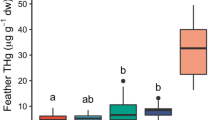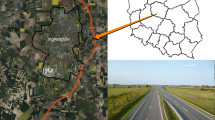Abstract
We examined feather molt progress of northern fulmars (Fulmarus glacialis) at Cape Vera in the Canadian High Arctic through opportunistic observation of individuals in flight from 2003 to 2006, and examination of bodies and wings of 127 individuals collected at the site, from 2003 to 2005. We found no evidence suggesting that fulmars shed primary feathers during breeding. Prebasic molt was initiated in the head, neck, sides, belly and back approximately 1 week before hatch. We failed to detect a sex effect on molt progress, but molt among breeders was delayed compared to molt in non- or failed breeders. This study constitutes a baseline we feel may be useful to: (1) researchers interested in feather replacement chronology, wherein feathers are used as sources of biological information; and (2) researchers interested in eventual assessment of relationships among large-scale environmental processes and molt progress in this species, especially in light of predicted changes to Arctic regions.



Similar content being viewed by others
References
Ashmole NP (1962) The black noddy (Anous tenuirostris) on Ascension Island. Ibis 103:235–273
Barbraud C, Chastel O (1998) Southern fulmars molt their primary feathers while incubating. Condor 100:563–566
Beck JR (1970) Breeding seasons and moult in some smaller Antarctic petrels. In: Holdgate MW (ed) Antarctic ecology, vol 1. Academic Press, London
Bridge ES (2006) Influences of morphology and behavior on wing-molt strategies in seabirds. Marine Ornithol 34:7–19
Bourne WRP (1966) The plumage of the fulmars of St. Kilda in July. Bird Study 13:209–213
Brown RGB (1988) The wing-moult of fulmars and shearwaters (Procellariidae) in Canadian arctic waters. Can Field Nat 102:203–208
Carrick R, Dunnet GM (1954) Breeding of the fulmar Fulmaris glacialis. Ibis 96:356–370
Chu EW (1984) Sooty shearwaters off California: diet and energy gain. In: Nettleship DN, Sanger GA, Springer PF (eds) Marine birds: their feeding ecology and commercial fisheries relationships. Can Wildl Serv Spec Publ, Ottawa, pp 64–71
Dott HEM (1973) Fulmars at land in summer and autumn. Bird Study 22:255–259
Duffey E (1950) Non-breeding in the fulmar Fulmarus glacialis. Scott Nat 62:111–121
Edwards DB, Mallory ML, Forbes MR (2005) Variation in baseline haematology of northern fulmars (Fulmarus glacialis) in the Canadian high arctic. Comp Clin Path 14:206–209
Falk K, Møller S (1995) Breeding ecology of the fulmar Fulmarus glacialis and the kittiwake Rissa tridactyla in high-arctic northeastern Greenland, 1993. Ibis 139:270–281
Fisher J (1952) The fulmar. Collins Publishing, London
Frederiksen M, Harris MP, Daunt F, Rothery P, Wanless S (2004) Scale-dependent climate signals drive breeding phenology of three seabird species. Glob Change Biol 10:1214–1221
Gaston AJ, Gilchrist HG, Mallory ML (2005) Variation in ice conditions has strong effects on the breeding of marine birds at Prince Leopold Island, Nunavut. Ecography 28:331–344
Ginn HB, Melville DS (1983) Moult in birds. Tring: British Trust for Ornithology
Grosbois V, Thompson PM (2005) North Atlantic climate variation influences survival in adult fulmars. Oikos 109:273–290
Hamer KC, Schreiber EA, Burger J (2002) Breeding biology, life histories, and life history–environment interactions in seabirds. In: Schreiber EA, Burger J (eds) Biology of marine birds. CRC Press, New York, pp 217–261
Harris MP (1971) Ecological adaptations of moult in some British gulls. Bird Study 18:113–118
Hatch SA (1979) Breeding and population ecology of northern fulmars (Fulmarus glacialis) at Semidi Islands, Alaska. MSc Thesis, University of Fairbanks, Alaska
Hatch SA (1989) Diurnal and seasonal patterns of colony attendance in the northern fulmar, Fulmarus glacialis, in Alaska. Can Field Nat 103:248–260
Hatch SA, Nettleship DN (1998) Northern fulmar (Fulmarus glacialis). In: Poole A, Gill F (eds) The Birds of North America, no. 361. The Birds of North America, Philadelphia
Hodum PJ, Hobson KA (2000) Trophic relationships among Antarctic fulmarine petrels: insights into dietary overlap and chick provisioning strategies inferred from stable-isotope (δ15N and δ13C) analyses. Mar Ecol Prog Ser 198:273–281
Holmgren N, Hedenström A (1995) The scheduling of molt in migratory birds. Evol Ecol 9:354–368
Hunter S (1984) Moult of the giant petrels Macronectes halli and M. giganteus at South Georgia. Ibis 126:119–132
King JR, Murphy ME (1985) Periods of nutritional stress in the annual cycles of endotherms: fact or fiction? Am Zool 25:955–964
Lesher SW, Kendeigh SC (1941) Effect of photoperiod on molting of feathers. Wilson Bull 53:169–180
Lindström A, Daan S, Visser GH (1994) The conflict between moult and migratory fat deposition: a photoperiodic experiment with bluethroats. Anim Behav 48:1173–1181
Mallory ML, Fontaine AJ (2004) Key marine habitat sites for migratory birds in Nunavut and the Northwest Territories. Can Wildl Serv Occas Pap No 109
Mallory ML, Forbes MR (2005) Sex discrimination and measurement bias in northern fulmars (Fulmarus glacialis) from the Canadian arctic. Ardea 93:25–36
Mallory ML, Forbes MR (2007) Does sea-ice cover constrain the breeding schedules of high arctic northern fulmars? Condor (in press)
Mallory ML, Braune BM, Forbes MR (2006a) Breeding and contaminant concentrations in northern fulmars (Fulmarus glacialis L.) from the Canadian high arctic. Chemosphere 64:1541–1544
Mallory ML, Forbes MR, Galloway TD (2006b) Ectoparasites of northern fulmars Fulmarus glacialis (Procellariformes: Procellariidae) from the Canadian Arctic. Polar Biol 29:353–357
Norstrom RJ, Clark TP, Kearney JP, Gilman AP (1986) Herring gull energy requirements and body constituents in the Great Lakes. Ardea 74:1–23
Payne RB (1972) Mechanism and control of molt. In: Farner DS, King JR (eds) Avian biology, vol 11. Academic Press, New York
Petrie SA (1998) Intensity and chronology of breeding and post-breeding moult in White-faced Whisting-Ducks (Dendrocygna viduata). Wildfowl 49:207–218
Raymont JEG (1976) Plankton and productivity in the oceans. Pergamon Press, Toronto
Ricklefs RE (1974) Energetics of reproduction in birds. In: Paynter RA (ed) Avian energetics. Publ Nuttall Ornithol Club 15
Robertson GJ, Cooke F, Goudie IR (1998) Moult speed predicts pairing success in male harlequin ducks. Anim Behav 55:1677–1684
Salomonsen F (1965) The geographical variation of the fulmar (Fulmarus glacialis) and the zones of marine environment in the North Atlantic. Auk 82:327–355
Swaddle JP, Witter MS (1997) The effects of molt on the flight performance, body mass, and behavior of European starlings (Sturnus vulgaris): an experimental approach. Can J Zool 75:1135–1146
Systat Software Inc (2002) Systat 10.2. Systat, Richmond
Thompson CW, Hatch SA, Leu M, Brennan K, Roca B, Krausse B (2000) Novel sequences of flight feather molt in sooty shearwaters and northern fulmars. Pac Seabirds 27:50
Thompson DR, Furness RW (1995) Stable-isotope ratios of carbon and nitrogen in feathers indicate seasonal dietary shifts in northern fulmars. Auk 112:493–498
Thompson JE, Drobney RD (1995) Intensity and chronology of post reproductive molts in male canvasbacks. Wilson Bull 107:338-358
Thompson P, Ollason JC (2001) Lagged effects of ocean climate change on fulmar population dynamics. Nature 413:417–420
Tickell WLN (2000) Albatrosses. Yale University Press, New Haven
Titman RD, Lagrenade MC, Miller MR (1990) An evaluation of techniques to measure contour feather molt in ducks. J Wildl Manage 54:219-222
Verbeek NAM (1977) Timing of primary moult in adult herring gulls and lesser black-backed gulls. J Ornithol 118:87–92
Visser ME, van Noordwijk AJ, Tinbergen JM, Lessells CM (1998) Warmer springs lead to mistimed reproduction in great tits (Parus major). Proc R Soc Lond Ser B 265:1867–1870
Warham J (1996) The behaviour, population biology and physiology of the petrels. Academic, London
Weimerskirch H (1991) Sex-specific differences in molt strategy in relation to breeding in the Wandering Albatross. Condor 93:731–737
Wynne-Edwards VC (1939) Intermittent breeding of the fulmar (Fulmarus glacialis), with some general observations on non-breeding in sea-birds. Proc Zool Soc Lond Ser A 109:127–132
Acknowledgments
This project would not have been possible without the financial and logistic assistance of Environment Canada (CWS), Natural Resources Canada (PCSP), the Nunavut Wildlife Management Board, Indian and Northern Affairs Canada (NCP, ECDI and NSTP), Carleton University, and NSERC. Thanks to the numerous field assistants on the Cape Vera Project in 2003–2005 and Prince Leopold Island in 2005, and to three anonymous referees for constructive reviews of the manuscript. Collections were made under permits as follows: animal care (2004PNR017, 2004PNR021), land use (59A/7–2-2), wildlife research (NUN-SCI-03-02, WL000714).
Author information
Authors and Affiliations
Corresponding author
Rights and permissions
About this article
Cite this article
Allard, K.A., Mallory, M.L., Wilcox, K.L. et al. Prebasic molt initiation and progress in northern fulmars of the High Arctic: do molt and breeding overlap?. Polar Biol 31, 181–188 (2008). https://doi.org/10.1007/s00300-007-0345-4
Received:
Revised:
Accepted:
Published:
Issue Date:
DOI: https://doi.org/10.1007/s00300-007-0345-4




